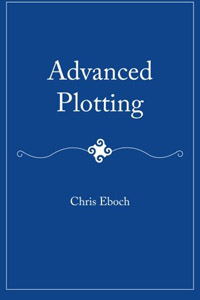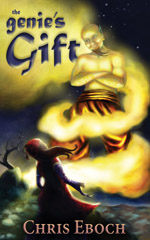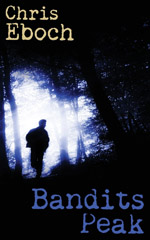by Chris Eboch
 People often ask writers, “Where do you find your ideas?” But for a writer, the more important question is, “What do I do with my idea?”
People often ask writers, “Where do you find your ideas?” But for a writer, the more important question is, “What do I do with my idea?”
If you have a “great idea,” but can’t seem to go anywhere with it, you probably have a premise rather than a complete story plan. A story has four main parts: situation, complications, climax, and resolution. You need all of them to make your story work.
The situation should involve an interesting main character with a challenging problem or goal. Even this takes development. Maybe you have a great challenge, but aren’t sure why a character would have that goal. Or maybe your situation is interesting, but doesn’t actually involve a problem.
For example, I wanted to write about a brother and sister who travel with a ghost hunter TV show. The girl can see ghosts, but the boy can’t. That gave me the characters and situation, but no problem or goal. Goals come from need or desire. What did they want that could sustain a series?
Tania feels sorry for the ghosts and wants to help them, while keeping her gift a secret from everyone but her brother. Jon wants to help and protect his sister, but sometimes feels overwhelmed by the responsibility. Now we have characters with problems and goals. The story is off to a good start.
Make sure your idea is specific and narrow. Focus on an individual person and situation, not a universal concept. For example, don’t try to write about “racism.” Instead, write about one character facing racism in a particular situation.
Ask why the goal is important to the character. The longer the story, the higher stakes needed to sustain it. A short story character might want to win a contest; a novel character might need to save the world.
Ask why this goal is difficult. Difficulties fall into categories traditionally called man versus man, man versus nature, and man versus himself. You can even combine these. Your character may hunt bank robbers (man versus man) during a dangerous storm (man versus nature) when he is afraid of lightning (man versus himself).
Even if your main problem is external, give the character an internal flaw that contributes to the difficulty. This adds complications and also makes your character seem more real. For some internal flaw, see the seven deadly sins: lust, gluttony, greed, sloth, wrath, envy, and pride.
 Test the idea. Change the character’s age, gender, or looks. Change the point of view, setting, external conflict, internal conflict. Choose the combination that has the most dramatic potential.
Test the idea. Change the character’s age, gender, or looks. Change the point of view, setting, external conflict, internal conflict. Choose the combination that has the most dramatic potential.
If a character solves his goal easily, the story is boring. To keep tension high, you need complications.
For short stories, try the “rule of three” and have the main character try to solve the problem three times. The first two times, he fails and the situation worsens. Remember: the situation should worsen. If things stay the same, he still has a problem, but the tension is flat. If his first attempts make things worse, tension rises.
For novels, you may have even more attempts and failures. In my first Haunted book, The Ghost on the Stairs, I made sure each ghost encounter felt more dangerous. As Tania tries to get closer to the ghost in order to help her, Jon worries that she will go too far and be injured or even killed. With enough variety, you can sustain this kind of tension indefinitely (witness the ongoing battle between Harry and Voldemort in the seven-book Harry Potter series).
You can worsen the situation in several ways. The main character’s actions could make the challenge more difficult. In my new mystery set in ancient Egypt, The Eyes of Pharaoh, a young temple dancer searches for her missing friend. But when she asks questions at the barracks where he was a soldier, she attracts dangerous attention from his enemies.
The villain may also raise the stakes. In my Mayan historical drama, The Well of Sacrifice, the main character escapes a power-hungry high priest. He threatens to kill her entire family, forcing her to return to captivity.
Secondary characters can cause complications, too, even if they are not “bad guys.” In The Ghost on the Stairs, the kids’ mother decides to spend the day with them, forcing them to come up with creative ways to investigate the ghost while under her watchful eyes.
Finally, the main character may simply run out of time. At her first attempt, she had a week. At her second attempt, she had a day. Those two attempts have failed, and now she has only an hour! That creates tension.
For each turning point in the story, brainstorm 10 things that could happen next. Then pick the one that is the worst or most unexpected, so long as it is still believable for the story.
Coming next month: how to build the climax and finish your story.
 Chris Eboch writes fiction and nonfiction for all ages. In Bandits Peak, a teenage boy meets strangers hiding on the mountains and gets drawn into their crimes, until he risks his life to expose them. The Eyes of Pharaoh is an action-packed mystery set in ancient Egypt. The Genie’s Gift is an Arabian Nights-inspired fantasy adventure. In The Well of Sacrifice, a Mayan girl in ninth-century Guatemala rebels against the High Priest who sacrifices anyone challenging his power. Her writing craft books include You Can Write for Children: How to Write Great Stories, Articles, and Books for Kids and Teenagers and Advanced Plotting.
Chris Eboch writes fiction and nonfiction for all ages. In Bandits Peak, a teenage boy meets strangers hiding on the mountains and gets drawn into their crimes, until he risks his life to expose them. The Eyes of Pharaoh is an action-packed mystery set in ancient Egypt. The Genie’s Gift is an Arabian Nights-inspired fantasy adventure. In The Well of Sacrifice, a Mayan girl in ninth-century Guatemala rebels against the High Priest who sacrifices anyone challenging his power. Her writing craft books include You Can Write for Children: How to Write Great Stories, Articles, and Books for Kids and Teenagers and Advanced Plotting.
Learn more at www.chriseboch.com or her Amazon page, or check out her writing tips at her Write Like a Pro! blog. Sign up for her Workshop newsletter for classes and critique offers.
Chris also writes novels of suspense and romance for adults under the name Kris Bock; read excerpts at www.krisbock.com.
This article was originally published in the April 2011 issue of SouthWest Sage and is reprinted here by permission of the author.


[…] For me it’s all about the characters. I have written plot-driven stories. (As a matter of fact, I found out just yesterday my latest plot-driven short story has been accepted by an anthology!) When I start a story, I tend to start in the middle of an argument between one main character and the antagonist or a minor character who gets chewed up and spat out. Open with conflict. Show the reader why the main character’s life has just been drastically complicated by the problem situation. […]